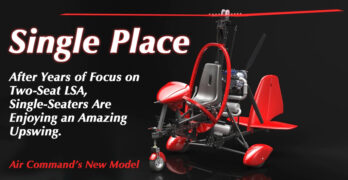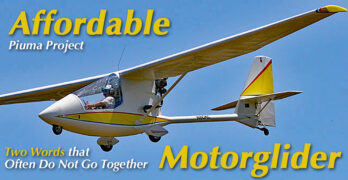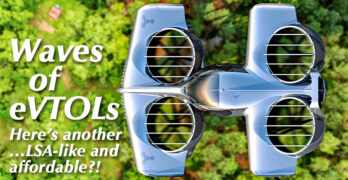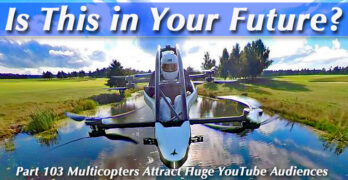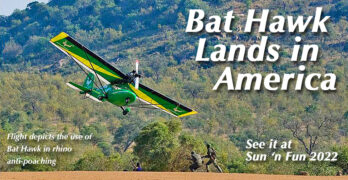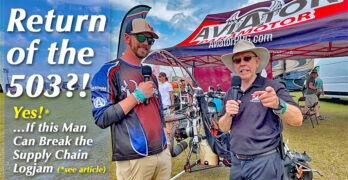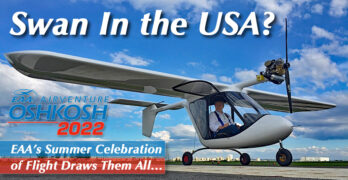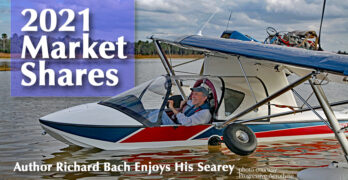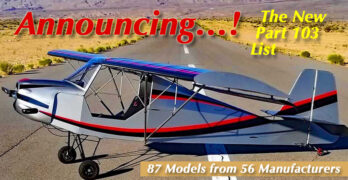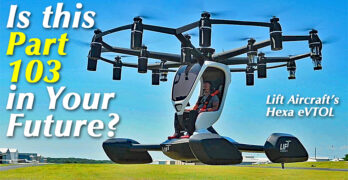I am longtime enthusiast of single place aircraft. Clearly, I am not alone. In fact, the number of pilots showing an interest in single-place aircraft has been growing fast according to several ways of estimating such interest.
When you fly solo you can operate your flying machine the way you want — well… within the laws of physics and the laws of FAA (or whatever national CAA you must obey). What you don’t need to do is worry about a passenger.
Single place aircraft are commonly much more affordable.
Despite following single place aircraft closely, even I have been astounded at steadily increasing interest in single place aircraft over the last few years. Although significantly out of sight of many aviators, single place aviation has been growing faster than you imagine. Some pilots actually think Part 103 “died” a couple decades back. I don’t know how it feels to be that wrong, but they are.
Search Results for : MG 21
Not finding exactly what you expected? Try our advanced search option.
Select a manufacturer to go straight to all our content about that manufacturer.
Select an aircraft model to go straight to all our content about that model.
Affordable Motorgliders? Yes, a Whole Family of Them You Can Build
Article Update — Photos of the designer’s own project… see at bottom. —DJ 3/2/22
A steady stream of readers ask about motorgliders. This is one of recreational aviation’s most interesting aircraft types. Motorgliders can soar reasonably well for those interested in working thermals or ridge lift to ascend without motor noise.
Many others might never shut down the engine and soar but are intrigued with efficient cross country flying. In a motorglider, a pilot can be more confident as the aircraft can glide far further than other types, providing a broader safety margin.
From a one-man operation comes the Italian Piuma Project. Designer and builder Tiziano Danieli describes his creations as “a friendly family of ultralight* motor gliders.”
Trouble Is…
Motorgliders Are Expensive
…Or, Are They?
Fully manufactured LSA motorgliders may get you airborne quickly whereas you need to build your Piuma, but the factory-built version will cost substantially more.
LSA-Sized eVTOL Takes a Different (Ducted) Approach — Reasonably Priced?
I promise I will not keep reporting futuristic eVTOLS or multicopters. However, since the Jetson One article went over better than expected and since I’ve focused mainly on Part 103-sized multicopters, how about one that is LSA-sized?
I still would not follow one multicopter article with another except for developer Doron Merdinger, saying this, “Suggested [selling price is] $135,000 to $150,000.” That got my attention. From what I’ve seen so far, any eVTOL larger/heavier than a Part 103 entry is way, way more expensive.
Beyond that come air taxies… 4-6-8 seater urban air transport aircraft. Those I will never report as they are commercial by design and cost far beyond any Sport Pilot’s budget. In addition, it could be years before they actually enter the market.
Can Doroni Do It?
However, a two-seater, ducted-fan, LSA-like aircraft with a 500 pound payload for $135-150,000 could actually be something some readers might consider.
Are We Current Sport Pilots and Our Aircraft an Endangered Species?
By my study and reports from several other organizations, the world has somewhere north of 1,000,000 pilots. That estimate includes all airline, military, GA, and recreational pilots even including hang glider and paraglider pilots and sky divers. One million, more or less.
Now, as anyone who has not been vacationing on Mars the last couple months probably knows, another new multicopter is captivating YouTube gazers.
Dubbed Jetson One after the famous TV cartoon from decades past, this small vehicle is certainly intriguing… even if you are one of many current-day pilots who dismiss these aircraft. The video below has been viewed more than 14 million times in three months!
Not only haven’t we seen the last of this, more likely this is just the beginning.
No, Not Air Taxis…
Recreational Multicopters
Look, this article is not about air taxis or so-called UAM vehicles (Urban Air Mobility, according to some who enjoy making up new names for these multi-motored flying contraptions).
Bat Hawk: Well-Established South African Aircraft Lands in America
It’s always exciting to welcome a new entry into recreational aviation. Two Bat Hawks are presently inside the USA and will be debuted at Sun ‘n Fun 2022.
Bat Hawk is a well-established, conventional microlight-style light aircraft powered by a Rotax 912 that helps it provide “sensational” performance.
“We now have two planes in the country,” said importer and representative Gary Saitowitz, “and we just received our FAA Special Airworthiness Certificate at the end of 2021.” At this time, Bat Hawk is not a Special LSA. As they get started with the new-to-Americans model, both are registered Experimental Exhibition. After Bathawk Aircraft USA can gauge market interest, they may pursue another level of FAA approval.
LSA with a Purpose
“Like a bat outta…” in this case, South Africa not that hotter place. Kidding aside, Bat Hawk is positioning itself as a very capable workhorse. Their website shows a great many activities for which this aircraft is being used, perhaps most notably, as a workhorse for rhino anti-poaching actions.
What’s Affordable in 2022? A New “503,” Wheeled-Carriages, and Two-Place PPGs
For years — no, make that decades — numerous pilots of light aircraft have told me the Rotax 503 was their favorite two-stroke engine.
These days, it’s much more likely a pilot will go on about how great the Rotax 912 is. Yes, some grumble about the purchase price, the replacement parts cost, or the cost of an overhaul, but I’d expect to hear such groaning about almost any aviation product. Contrasting a few negative opinions is an entire world of pilots who are intensely loyal backers of the 9-series engines.
Around the planet, I have identified more than 66,000 light aircraft and 70-80% of them use a Rotax 9-series engine as their powerplant. Every other brand occupies the remaining 20-30% space, including some other fine and reliable engines. No matter how you spreadsheet the numbers, Rotax is far and away the dominant brand …although no longer in two-strokes.
Coming to America — Avi Aircraft’s Swan Could Debut at Oshkosh 2022
In the early days of Light-Sport Aircraft, a veritable tsunami of flying machines crossed the Atlantic or Pacific to land on American shores. In the earliest days imported aircraft comprised more than two-thirds of all entries on the market and that situation persisted for a few years.
Later, American companies — which had been relegated to building kit aircraft due to regulations at the time — joined the growing parade. Today American-made LSA represent better than half of total registrations.
Of course, U.S.-based kit-aircraft makers continue to do well as my recent article showed. Fully manufacturing an aircraft is quite a dissimilar business model from manufacturing a complete kit and supporting home builders (arguably the bigger task). Both are demanding enterprises but require different staff, different facilities, and different machinery.
Hidden to Visible
Although I have been an advocate of Part 103 ultralight vehicles since they first began in 1982, for many years this was something of a sparse, desert landscape with fewer choices than many of us would’ve preferred and almost no news coverage about them.
LSA and Sport Pilot Kits Offer Aircraft Your Way: Factory-Built or Kit-Built
Barely after we rang in the new year, here’s a review of 2021 market shares and info regarding the state of the light, recreational aircraft industry. After a surprisingly strong 2020 despite Covid, 2021 returned to Earth a bit but with some shifting between categories. This year the contrast that stood out was between Factory-Built and Kit-Built.
In 2020, perhaps because builders were locked down at home and completed more projects, kit registrations blew the doors off factory-built. For 2021, the ratio equalized again with kits narrowly edging out factory-built (nearby chart).
Note that for this reporting, datastician Steve Beste said, “We define kit-built as aircraft registered as Experimental Amateur Built. Factory-built are everything else, including SLSA, ELSA, Exhibition, Primary, and Standard.” To understand how Steve solves the FAA database mysteries, check this PDF.
How Healthy Is the Market?
Generally speaking, the leaders from 2019 and 2020 remain in similar positions for 2021 — the second year everyone endured the virus pandemic.
Announcing: Launch of the Part 103 List, a One-of-a-Kind Resource in Affordable Aviation
To welcome a brand new year in affordable aviation, I am pleased to announce the launch of our Part 103 List. This new list presents 89 Part 103 entries for models built by 57 manufacturers.
[UPDATE 1/18/22 — We made the 103 List even better with the “Model column now leading to info right here on ByDanJohnson.com, when available. Other article changes are shown in red text. —DJ]
Too many people believe this is a minor sector with “no fixed wing aircraft that qualify.” They’re wrong; we have 38 fixed wing producers alone. Some others among the general aviation pilot population thought that Part 103 ultralights had disappeared completely. They could not be more wrong.
Not only are plenty of Part 103 ultralights being produced, they come in many diverse shapes and plenty of them are being sold.
Clearly, it’s about time a list like this one got published to put the record straight!
A Multicopter for the Rest of Us? Part 103 eVTOL Hexa Is Preparing for a U.S. Tour
You can hardly follow any media without finding some article about the latest whizzbang electric propulsion multicopter project that “will transform urban transportation!” Or so they breathlessly exclaim.
Fine. I look forward to going from a downtown hotel to the airport in minutes versus slogging through ground traffic for an hour. Will these arrive in some near future? Maybe. Even if they do arrive sooner than later, would a pilot feel entirely comfortable flying in an autonomous, computer-controlled aircraft? Only you can answer that question.
You might get a chance sooner than you think.
Whatever you think right now, would you change your mind if you got to fly one of these machines, safely, of course?
Since autonomous operation is part of the plan, a current-day Lift Aircraft Hexa could take over any time and land safely on its own. Heck, my ancient (3-year-old) DJI drone can do that, with zero input from me.
- « Previous Page
- 1
- …
- 21
- 22
- 23
- 24
- 25
- …
- 94
- Next Page »


